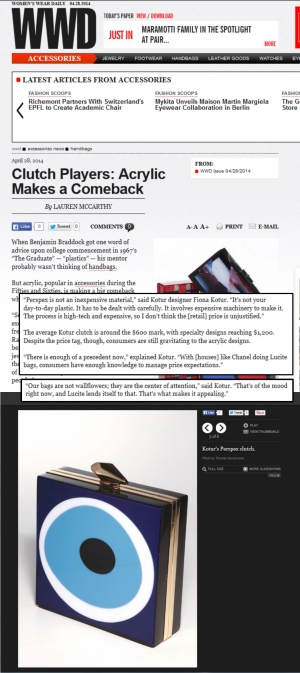Clutch Players: Acrylic Makes a Comeback
“So much of evening has been inundated with exotics and there is so much more flexibility and freedom that you have with the synthetics,” said Rauwolf designer Kristine Johannes. “You can bend them and shape them and polish them like jewels, and that’s making them fresh. I think there was a lot of boredom in the evening market of the last several years….I was one of the bored people.”
A bevy of handbag designers, like Rafe and Les Petits Joueurs as well as major houses like Chanel, have embraced the synthetic, putting a modern spin on the aesthetic.
“Anytime people see our bags, they are like ‘My grandma had one of those,’” said Edie Parker’s Brett Heyman. “I think it’s nice that there is this nostalgia around it and they can be kept like little pieces of jewelry.”
In 1907, chemist Leo Baekeland, the father of the modern plastics industry, created the first plastic that held its shape after being heated when he was mixing chemicals in search of a synthetic for use in electronic insulation. He trademarked his new compound Bakelite.
In the late Thirties, DuPont developed its own synthetic, dubbed Lucite. Around the same time, Rohm and Haas Chemical Co. created a chemically identical compound called Perspex, which was marketed primarily toward industrial work.
Acrylic fashion accessories rose to prominence after World War II, with manufacturers creating expensive, hand-carved designs in bright colors. Manufacturer Rialto was the first to produce a machine-made bag, using injected molds, which brought the trend to the masses.
Today, acrylic is defined as a high-grade plastic made primarily from petroleum. Unlike most cheaper plastics, high-quality acrylic will not turn yellow when exposed to sunlight or harsh conditions. Popular branded acrylics include Lucite, Perspex, Plexiglas and Acrylite.
Despite the material being used for more than half a century, today’s designers still struggle while working with the difficult synthetic.
“I thought it would be so easy,” said Heyman. “They’ve been making them since the Sixties….But we don’t work with a bag manufacturer — we work with people in plastic. I talked to a man who made the bags back then and he gave me some old heat forms. We’re basically very true to that method, with some obvious advancements in cutting.”
While some designers continue to hand or laser cut from sheets of Plexiglas, molds have become a popular option.
“We put blocks of Plexiglas through a laser machine and actually cut out the mold of the bag,” explained Thalé Blanc designer Debora Sawaf. “The laser has the memory for the mold of the clutch, and cuts out the shape of the bag. A lot of Plexi bags are cut from a sheet and glued. When you do that, they fall apart after a certain amount of time because acrylic is plastic and tends to expand and contract with heat. That doesn’t really happen when you use a mold.”
Although molds help with production headaches, the advanced technology drives up retail prices, as well as limits the opportunity for mass production.
“Perspex is not an inexpensive material,” said Kotur designer Fiona Kotur. “It’s not your day-to-day plastic. It has to be dealt with carefully. It involves expensive machinery to make it. The process is high-tech and expensive, so I don’t think the [retail] price is unjustified.”
The average Kotur clutch is around the $600 mark, with specialty designs reaching $1,200. Despite the price tag, though, consumers are still gravitating to the acrylic designs.
“There is enough of a precedent now,” explained Kotur. “With [houses] like Chanel doing Lucite bags, consumers have enough knowledge to manage price expectations.”
With such a crowded playing field, the pressure to create the most creative and eye-catching designs has intensified — a challenge most have embraced.
“I’ll use Swarovski crystals,” said Sawaf of her designs. “I’ll laser and engrave them. I’ll do inlays of leather, or a cheetah design. I love to create new techniques.”
Charlotte Olympia has made a colorful mark in the saturated market with her vibrant, quirky designs. Offerings from her namesake line include bags in the shape of vinyl records, gummy bears, cherries and seashells.
“They become wearable objects that you can also display,” said Olympia.
Heyman has created her own niche in the field with Edie Parker’s personalized pieces, carried by the likes of Anna Dello Russo, Nicky Hilton and Miranda Lambert. The first iteration was created as a 40th birthday present for Lizzie Tisch.
“Certainly, we didn’t invent monograms,” said Heyman. “But the idea of putting your whole name on an evening bag is really fun. It’s really taken off.”
And whether hashtagged or food-shaped, glittered or bejeweled, today’s acrylic bags have all come a long way from the basic designs of yore.
“Our bags are not wallflowers; they are the center of attention,” said Kotur. “That’s of the mood right now, and Lucite lends itself to that. That’s what makes it appealing.”
